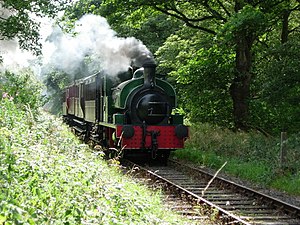Tanfield Railway
|
|
|
|---|---|
| An overview of the railway from Furnace Sidings | |
| Locale | North East England |
| Coordinates | 54°54′29″N 1°40′30″W / 54.908°N 1.675°WCoordinates: 54°54′29″N 1°40′30″W / 54.908°N 1.675°W |
| Commercial operations | |
| Name | Tanfield Railway |
| Original gauge | Wooden Waggonway / Iron 4 ft 8 1⁄2 in (1,435 mm) standard gauge |
| Preserved operations | |
| Stations | 4 |
| Length | 3 miles (4.8 km) |
| Preserved gauge | 4 ft 8 1⁄2 in (1,435 mm) standard gauge |
| Preservation history | |
The Tanfield Railway is a 4 ft 8 1⁄2 in (1,435 mm) standard gauge heritage railway in Gateshead and County Durham, England. Running on part of a former colliery wooden wagonway, later a steam railway, it operates preserved industrial diesel and steam tank locomotives. The railway operates a passenger service on Sundays all year round, as well as demonstration freight trains. The line runs 3 miles (4.8 km) between a southern terminus at East Tanfield, Durham, to a northern terminus at Sunniside, Gateshead, with the main station, Andrews House situated near to the Marley Hill engine shed. A halt also serves the historic site of the Causey Arch. The railway claims to be "the world's oldest railway".
The Tanfield Railway was originally built to transport coal from the collieries of County Durham, to the staithes on the River Tyne, for onward transport in colliers (bulk coal carrying ships). The oldest part of the original Tanfield Railway, located to the north east of the present heritage line, in the Lobley Hill area, dated from 1647, and was in continuous use until final closure in 1964.
The route and structures of the oldest section of the now preserved part of the line, between Sunniside and Causey, dates from 1725, and is thus claimed to be the world's oldest railway. The Middleton Railway claims to be the oldest working railway, on the basis that it was the first railway granted powers under the first railway Act of Parliament in 1758. The Causey to East Tanfield section was built in 1839.
The Marley Hill engine shed was built in 1854, and in use until 1970. The shed first housed a winding engine before the arrival of locomotives. The shed was originally on the Bowes Railway, with locos used on the Tanfield branch stabled at the nearby Bowes Bridge MPD (a sub-shed of Gateshead), the coaling stage and turntable pit of which are still visible adjacent to the track between Andrews House and Sunniside. The headshunt by the signal box is the point where the Bowes Railway crossed the Tanfield branch. When the line was re-opened a curve was installed to allow trains access to the shed. It is thought to be the oldest engine shed in the world still used for its original function. Although the line to the shed closed in 1962, it remained in use servicing other colliery railway's locomotives in the area.
...
Wikipedia

